Refrigerator Manufacturers Call for a Regulatory Freeze
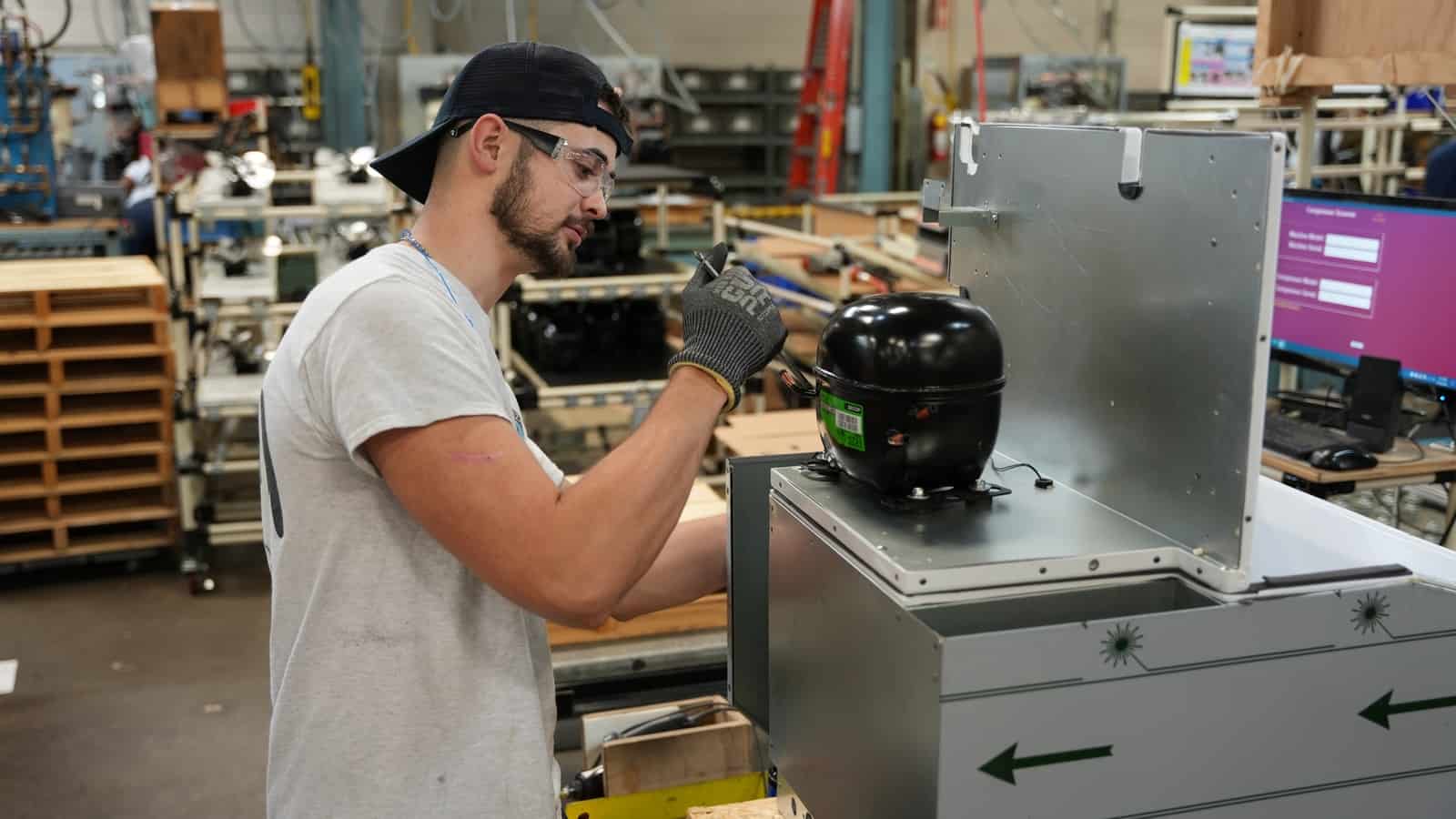
If you’ve ever found yourself grateful for a cold beverage on a hot day, chances are you’ve got Hoshizaki America to thank. The company was established in Los Angeles, California, in 1981 and is one of the leaders in commercial refrigeration, manufacturing refrigerators and icemakers that are used in hotels, hospitals, arenas, schools and more.
Its manufacturing facility was completed in Peachtree, Georgia, in 1986, and it proudly makes its products in America—but in recent years, that commitment has become much more costly.
The problem: Manufacturers like Hoshizaki America are meticulous in adhering to the energy and environmental standards put forth by federal agencies, including the Environmental Protection Agency and the Department of Energy. However, the increased pace of regulation and a lack of coordination between agencies are making it impossible to keep up, according to Hoshizaki America Compliance Engineer Stephen Schaefer.
- “We have many agencies that we have to talk to and be in compliance with, and right now, we’ve got a lot of things coming to a head all at the same time,” said Schaefer.
- “The Department of Energy is setting minimum energy-efficiency standards, the EPA is saying what refrigerants we’re allowed to use, and we’ve got safety standards being updated. That’s a lot of testing and evaluation.”
The timeline: It isn’t just the volume of work that needs to be done; it’s also the short timelines. Appraisals of the industry’s products used to come every six or seven years, allowing companies to develop new technologies to meet new regulations.
- But now, as different agencies offer different rules on overlapping and shorter timelines, companies are finding it impossible to research, build and test new products in time.
- “We fully agree that there are things we want to do environmentally, but there needs to be time given,” said Schaefer.
The scope: Hoshizaki isn’t alone. Schaefer is chair of the Technical Liaison Committee for the North American Association of Food Equipment Manufacturers, and much of the organization’s membership is experiencing the same challenge.
- According to a recent NAFEM survey of its membership, 66% of the companies indicated that their biggest challenges are the volume of regulations and cost of compliance.
The tradeoff: Schaefer argues that meeting these overlapping and pressing deadlines requires diverting funds that would otherwise be used for innovation. If companies are forced to spend more money figuring out how to meet requirements using existing products, they will have less money to spend on developing new products.
- “When different standards like this go into place, you’re taking away from ingenuity for new products and just making sure that existing products can be sold,” said Schaefer. “It becomes very tough to have newer innovation.”
- In the NAFEM survey, respondents said that if the regulatory burden was eased, they would be able to redirect funds to purchase new equipment, hire more employees, increase wages and benefits and reinvest in their manufacturing business.
The bottom line: “We want to help environmentally in every way possible—to be a good steward for energy efficiency and environmental concerns,” said Schaefer. “But we also want agencies to work together for the same goals, in a fair way that doesn’t impede ingenuity or increase the cost to the end user.”
Read more: Federal regulations are burdening manufacturers disproportionately—costing small companies an average of $50,100 per employee, according to a new NAM-commissioned study.
Regulatory Onslaught Costing Small Manufacturers More Than $50,000 Per Employee
Washington, D.C. – The federal regulatory burden is now costing small manufacturers $50,000 per employee per year, according to the topline findings of a forthcoming National Association of Manufacturers study on the macroeconomic impact of the onslaught of federal regulations. The total cost of federal regulations, estimated at more than $3 trillion dollars, outpaced the economic output of the entire manufacturing sector.
“The unbalanced federal regulations make it challenging to grow manufacturing in America by siphoning resources away from job creation and our communities,” said NAM President and CEO Jay Timmons. “The burden continues to grow year after year, undermining the bipartisan achievements from President Biden and Congress that have prioritized manufacturing—including the Bipartisan Infrastructure Law and the CHIPS and Science Act. It is chilling investment, curtailing our ability to hire new workers and suppressing wage growth, especially for small and medium-sized manufacturers. It is time for the Biden administration to take action to reverse course.”
Additional Key Facts:
- The total cost of federal regulations in 2022 is an estimated $3.079 trillion (in 2023 dollars), an amount equal to 12% of U.S. GDP and larger than the manufacturing sector’s entire economic output ($2.91 trillion). The total annual cost of complying with federal regulations has risen by $465 billion since 2012, after adjusting for inflation.
- The annual cost burden for an average U.S. firm is $277,000, the equivalent of 19% of the average firm’s payroll expenses. A small manufacturer pays a burden of $50,100 per employee, meaning that a small firm with 20 employees bears around $1 million in annual compliance costs.
- For the manufacturing sector, the cost of federal regulations is roughly $350 billion, which equals to 12% of the sector’s value added to GDP. This is 26% higher than the inflation-adjusted cost of $277 billion borne by manufacturers in 2012.
- Surveyed manufacturers indicate that they could enhance their competitiveness if the costs of federal regulations were reduced; they would reallocate current compliance funds toward employee compensation and hiring, investment, research and development, sales and marketing, enhancing price competitiveness and improving return on investment.
- The regulatory burden on the manufacturing sector is larger than the economies of 29 American states.
To view the executive summary of the forthcoming study, click here.
Background:
The NAM and members of the Manufacturers for Sensible Regulations coalition have been leading voices on the negative impact of unbalanced regulations on manufacturers. According to the NAM’s Q2 2023 Manufacturers’ Outlook Survey, more than 63% of manufacturers report spending more than 2,000 hours per year complying with federal regulations, while more than 17% of manufacturers report spending more than 10,000 hours annually.
The NAM’s Q3 2023 Manufacturers’ Outlook Survey found that 69.1% of small manufacturers, and 63.2% of all respondents, would hire more workers or increase compensation if the regulatory burden decreased. Additionally, more than 70% of manufacturers would purchase more capital equipment if the regulatory burden on manufacturers decreased, with 48.6% increasing compensation, 48.6% hiring more workers, 42.5% expanding their U.S. facilities and 38.4% investing in research.
About the Study:
The NAM commissioned this analysis by economists Nicole V. Crain* and W. Mark Crain, who continued a three-decade effort to analyze the total cost of federal regulations, and how the burden is distributed across sectors and firm sizes. Two approaches are employed. The first is a survey of NAM members, conducted from July 20 to Sept. 1, 2023, to collect information about operational expenses dedicated to regulatory compliance, extrapolating these findings to the sector. The second approach derives estimates based on an aggregation of federal agency cost estimates, combined with regression analysis that measures the impact on overall economic output. The cost allocations by sector and firm size rely on data from the Bureau of Economic Analysis, the Bureau of Labor Statistics, the Census Bureau and the Internal Revenue Service.
*The views expressed in this study are those of the authors and do not reflect the official policy or position of the National Defense University, the Department of Defense or the U.S. government.
-NAM-
The National Association of Manufacturers is the largest manufacturing association in the United States, representing small and large manufacturers in every industrial sector and in all 50 states. Manufacturing employs nearly 13 million men and women, contributes $2.91 trillion to the U.S. economy annually and accounts for 55% of private-sector research and development. The NAM is the powerful voice of the manufacturing community and the leading advocate for a policy agenda that helps manufacturers compete in the global economy and create jobs across the United States. For more information about the NAM or to follow us on Twitter and Facebook, please visit www.nam.org.
Environmental Firm Langan Takes on ‘Forever Chemicals’
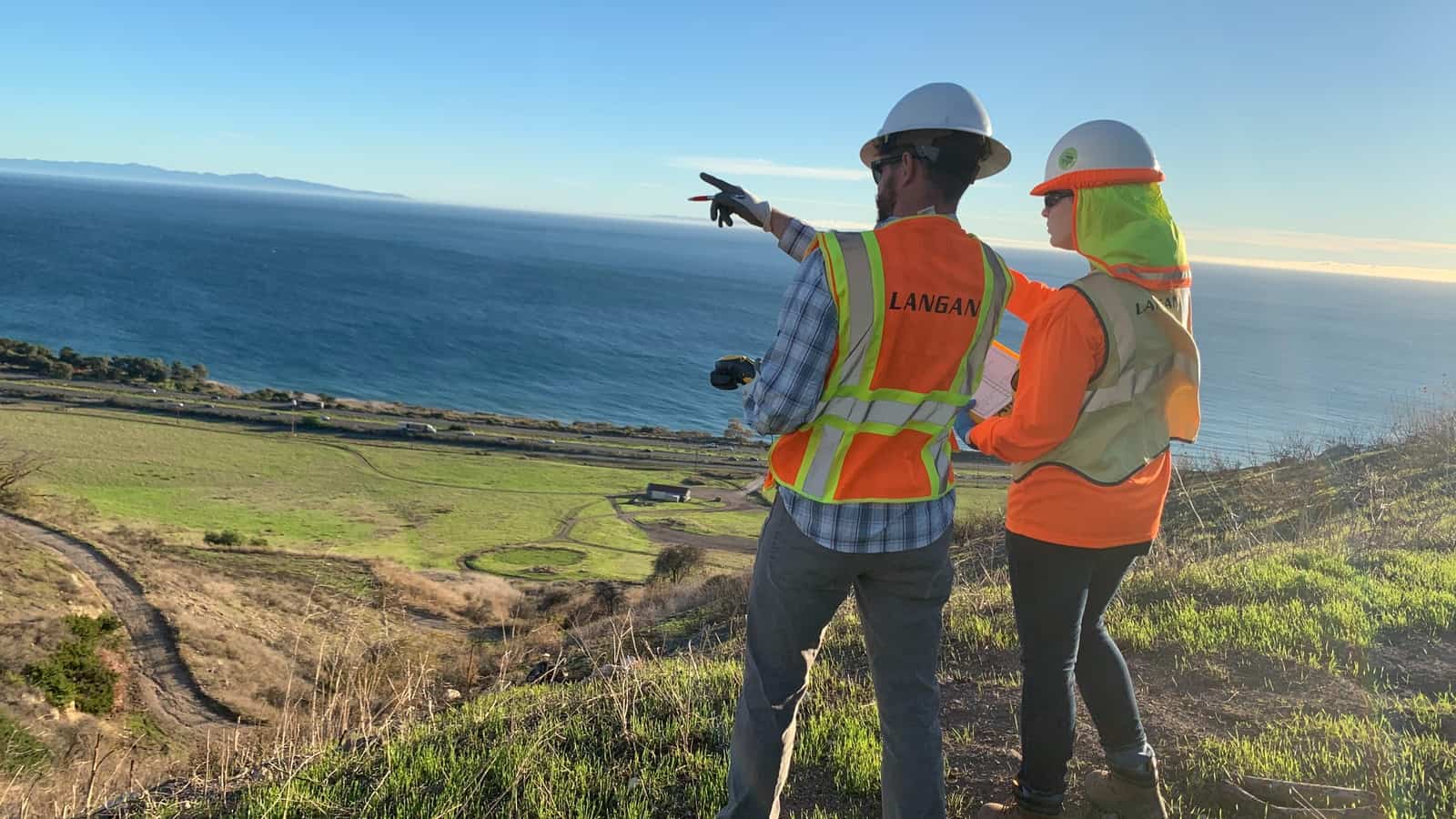
The race to remove PFAS from its remaining industry uses is on—and according to Langan’s Stewart Abrams, must be “a sprint, not a jog.”
In high demand: Abrams is a principal and director of remediation technology at Langan, a national environmental and engineering firm. He leads the consulting firm’s remediation practice, specializing in the treatment of perfluoroalkyl and polyfluoroalkyl substances, chemical compounds that were used widely in household products—including fire extinguishers—for decades.
- It’s an area of expertise that will soon be highly sought after, given the Environmental Protection Agency’s proposal earlier this year of drinking water maximum contaminant levels (MCL) of 4 parts per trillion (ppt) for both PFOA and PFOS. This will not only affect drinking water but will become an important standard for remediation sites as well.
- Langan has clients—including property owners and developers—who focus on the removal of PFAS from contaminated groundwater.
“What’s possible”: “Part of what Langan is doing is focusing on what is possible” regarding PFAS removal, Abrams said.
- “We’re looking at the treatment of groundwater and drinking water. We’re also working on how to deliver existing and new technologies to site cleanup. We’re going to have to move faster than ever before to bring these technologies to the marketplace. It’s a sprint, not a jog.”
Land remediation: Langan has long worked with property developers, helping them clear land of contaminants before building begins. PFAS issues, however, have changed the game considerably.
- “Now we’re looking at projects [for clients] where the question is, ‘How do you use water or land that’s been PFAS-contaminated?’” Abrams said.
- “Some companies have legacy contamination at the sites” they want to build on, and solutions aren’t always forthcoming, he continued.
Airports and PFAS: Another significant Langan customer sector? The aviation industry. Since 2022, airlines operating at California airports may no longer use PFAS in firefighting foam, a common use of the compounds for many years owing to their fire-extinguishing capabilities.
- “They’ve had to adopt new methods of firefighting at [California] airports,” said Abrams of Langan’s aviation clients in that state. “It’s hard because you need a lot of this fluid to address a fire given the amount of fuel on an airplane. The problem is that often the large water reservoirs at these airports have until recently contained a lot of PFAS.”
- That contamination isn’t limited to the water, Abrams added, but extends to everything the PFAS has touched. “Everything in the [firefighting] systems—the pumps, the nozzles, the piping—are contaminated, as is the storage reservoir itself. Part of the complexity of removal is cleaning all of it and then finding an alternative” surfactant, a chemical compound that can effectively extinguish fire.
- In addition, the sponge-like concrete that often lines the reservoirs at airports may have absorbed the chemical, requiring removal and replacement.
Finding solutions: About a decade ago, Langan and the New Jersey Institute of Technology began an informal research partnership.
- Members of Langan’s staff have access to NJIT’s environmental engineering laboratories, where they can set up experiments to solve client challenges. Now the company is leveraging that relationship to find solutions to PFAS problems.
- The labs are “a great [place] to bring in new ways of doing things with PFAS,” Abrams told us. “We’re exploring new treatment methods, new characterization methods, and we will be working to accelerate those technologies to market.”
Taking practical action: The strong carbon-fluorine bonds in PFAS chemicals render them harder to destroy than other contaminants, Abrams noted.
- “Unlike with other compounds—particularly volatile organic compounds and chlorinated solvents—with PFAS, we can’t quite track down all of it,” he continued. “It’s out there in the environment; it would be extremely difficult to chase down every molecule. Instead, we want to bring a theme of pragmatism to PFAS cleanup.”
Study: Tax Policy’s Harm Will Grow

The economic impact of allowing a stricter interest deductibility limitation to remain in effect could be devastating, according to a new EY analysis prepared on behalf of the NAM.
What’s going on: Failure to reverse the stricter limitation that went into effect in 2022 could result in the following losses in the U.S., according to the study:
- 867,000 jobs
- $58 billion in employee compensation
- $108 billion in gross domestic product
More costly every year: Those figures have roughly doubled since the 2022 EY analysis released last year.
- Last year, EY estimated that leaving the stricter limitation in place would result in 467,000 lost jobs, $23.4 billion in lost employee pay and $43.8 billion in lost GDP.
The background: Prior to 2022, companies could deduct interest of up to 30% of their earnings before interest, tax, depreciation and amortization (EBITDA).
- However, since 2022, the deduction has been limited to 30% of earnings before interest and tax (EBIT), a significant change that disproportionately affects manufacturers, given their capital-intensive investments.
What can be done: “A stricter interest expense limitation restricts manufacturers’ ability to invest in new equipment and create jobs,” said NAM Managing Vice President of Policy Chris Netram.
- “Even more, the study finds that manufacturers and related industries bear 77% of the burden of this policy. Congress must act by year’s end to restore a pro-growth interest deductibility standard and allow manufacturers to continue to invest for the future.”
NAM in the news: POLITICO Pro’s Morning Tax newsletter (subscription) covered the study’s release.
Further reading: Visit the NAM’s interest deductibility page to learn more about this issue and how the NAM is taking action.
NAM Study: Stricter Interest Expense Limitation to Cost Nearly 900,000 Jobs
Harmful Limit Disproportionately Impacts Manufacturing Sector
Washington, D.C. – The National Association of Manufacturers released a new analysis on the impact to the U.S. economy of Congress’ failure to reverse the stricter interest expense limitation that took effect in January 2022.
The jobs impact of the stricter limitation has nearly doubled over the past year given congressional inaction to ensure a pro-growth interest deductibility standard as interest rates have continued to rise. The data show that limiting manufacturers’ ability to deduct interest on debt-financed investments, over the long run, could cost the U.S. economy up to:
- 867,000 jobs;
- $58 billion of employee compensation; and
- $108 billion in GDP.
“A stricter interest expense limitation restricts manufacturers’ ability to invest in new equipment and create jobs. This analysis clearly shows that failing to reverse this damaging change will cut close to 900,000 jobs and billions of dollars of employee pay and harm economic growth. Even more, the study finds that manufacturers and related industries bear 77% of the burden of this policy,” said NAM Managing Vice President of Policy Chris Netram. “Congress must act by year’s end to restore a pro-growth interest deductibility standard and allow manufacturers to continue to invest for the future.”
Background:
Prior to 2022, the interest expense limitation was calculated based on a company’s earnings before interest, tax, depreciation and amortization (EBITDA). Last year, a stricter limitation based on a company’s earnings before interest and tax (EBIT) took effect. By excluding depreciation and amortization from the calculation, the stricter limitation increases the tax burden on manufacturers that make investments in long-lived capital equipment.
To view the full analysis click here.
-NAM-
The National Association of Manufacturers is the largest manufacturing association in the United States, representing small and large manufacturers in every industrial sector and in all 50 states. Manufacturing employs nearly 13 million men and women, contributes $2.91 trillion to the U.S. economy annually and accounts for 55% of private-sector research and development. The NAM is the powerful voice of the manufacturing community and the leading advocate for a policy agenda that helps manufacturers compete in the global economy and create jobs across the United States. For more information about the NAM or to follow us on Twitter and Facebook, please visit www.nam.org.
How Quantum Computing Can Combat “Forever Chemicals”
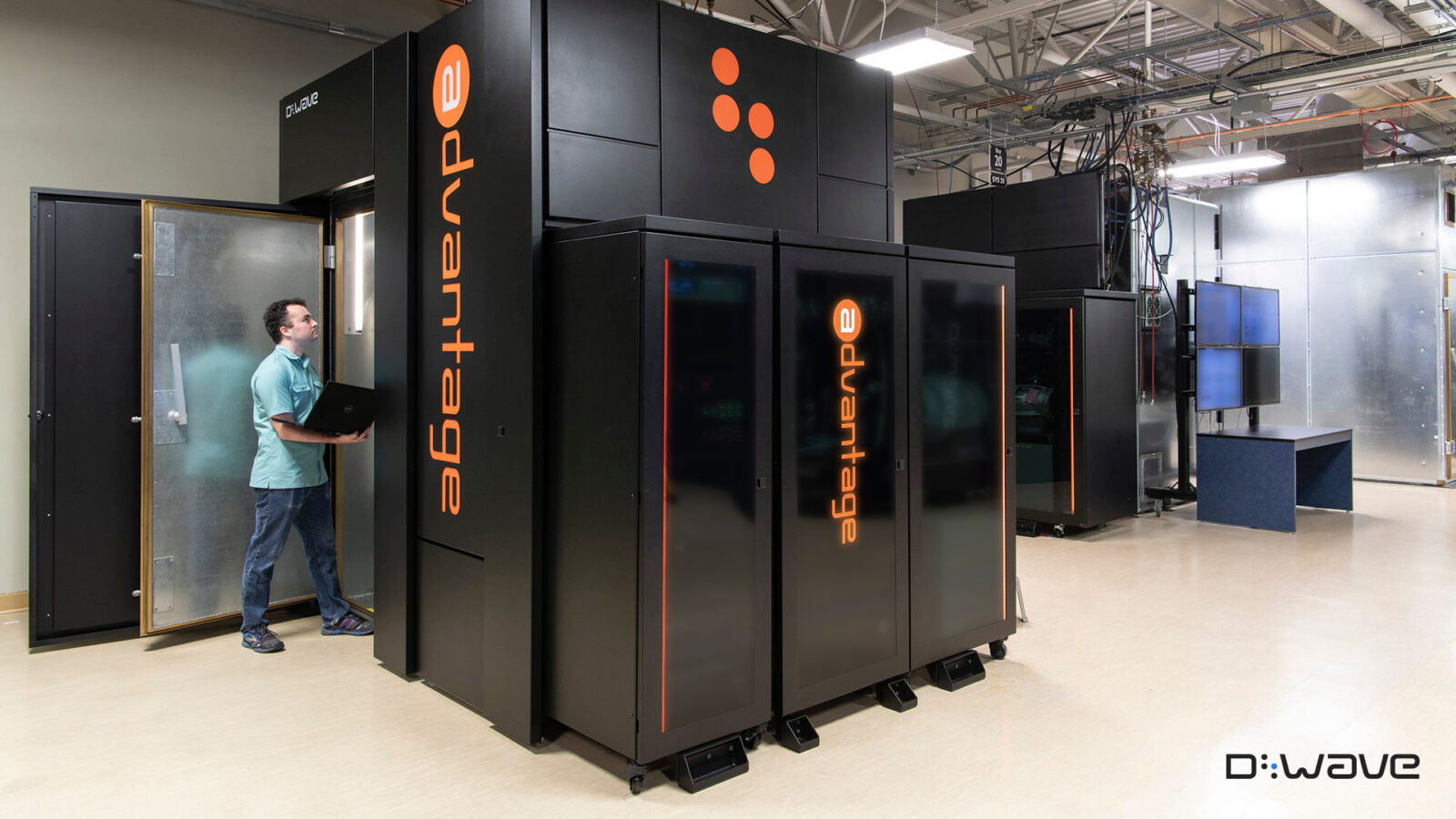
What sort of computer can evaluate 67 million potential solutions in 13 seconds? Only a quantum computer. But what sort of problem has 67 million solutions to begin with?
Many manufacturing challenges do, from optimizing supply chain logistics to finding the most efficient way to load millions of pallets. In recent years, another mind-bendingly complex problem has begun to occupy the industry: how to get potentially dangerous chemicals in a category known as PFAS out of use and out of our environment.
Quantum computing firm D-Wave says that quantum holds the key, as its massive computing power could find new ways to remove or remediate the chemicals, or even help identify which of the thousands of chemicals in this class are indeed dangerous. We recently spoke to D-Wave Global Government Relations and Public Affairs Leader Allison Schwartz to get the details.
How it works: As Schwartz explains it, quantum is “a completely different form of computing.”
- “Due to superpositioning and quantum entanglement, quantum can look at all possibilities at once and come back with an answer very quickly,” she said, in a way that classic computers just can’t match.
- However, some of the best solutions are a product of both classic computers and quantum, an option known as “hybrid” applications. For example, Davidson Technologies collaborated with D-Wave to create a hybrid solution that produced the aforementioned 67 million scenarios in 13 seconds.
- “Classical computing alone can’t do that,” Schwartz observed.
When quantum meets PFAS: So how does this help with PFAS? Schwartz told us that there are two different types of quantum computing that would prove useful.
- The first, annealing quantum computing systems, are superior at providing optimized solutions. These systems can quickly run through millions of scenarios that model potential chemical spills, methods of remediating the chemicals, techniques for removing them from operations entirely and much more. These systems are commercially available today through the cloud.
- Meanwhile, gate model systems offer another avenue for dealing with PFAS—they can potentially invent alternative molecules that could substitute for the dangerous chemicals. However, gate-model systems are not large enough yet to tackle real-world problems.
Doing the research: Quantum could also play a role in determining which chemicals are harmful in the first place, added Schwartz. There are thousands of PFAS chemicals out there, but so far, only a few hundred have been studied.
- To examine the effects of various chemicals, researchers and companies will have to undertake clinical trials. Quantum can help optimize the organization of those trials, as well as aid in analyzing the results—for example, by assisting with medical imaging reconstruction.
So what’s the holdup? With such a powerful tool at the ready, you might think policymakers would be jumping at the chance to encourage its use. In fact, quantum has yet to be used in a PFAS-related application, though Sens. Gary Peters (D-MI) and Joni Ernst (R-IA) mentioned its use in 2019 legislation later incorporated into the 2021 National Defense Authorization Act.
- However, “The EPA or DOE could recommend using quantum to optimize the PFAS work. It doesn’t need a legislative fix,” Schwartz noted. Instead, policymakers are more focused on finding replacement chemicals, a process that could take years, while incremental solutions could have a huge effect today.
- “Policymakers are relying on manufacturers to address the problem, but they aren’t providing insight into how emerging technology, such as quantum computing, can help manufacturers better achieve success,” said Schwartz.
Making quantum work for you: For manufacturers looking at quantum as a potential problem-solver, whether for PFAS or something else, Schwartz explained how D-Wave approaches new clients.
- First, a company’s leaders sit down with consultants at D-Wave, who conduct an in-depth examination of its operations—for example, by investigating which PFAS chemicals might be in use, how remediation might be accomplished or how contamination should be modeled.
- Once a problem or problems are identified, D-Wave builds a demo to test out potential options. It might build a custom algorithm or even a digital twin, as it did in partnership with SavantX to optimize container loading at the Port of Los Angeles. This step helps to hone the algorithm so it can find the right solutions for the manufacturer’s specific problem.
- Then D-Wave will work with the manufacturer to pilot the solution, making sure it functions as expected.
- And finally, the solutions are integrated into the production process and become part of daily operations.
The last word: “Tackling PFAS is a multipronged effort that calls for industry, academic and government collaboration,” said D-Wave CEO Dr. Alan Baratz. “Instead of waiting for a replacement chemical that could be years away, it is time to break down this societal problem and identify which parts of the problem can be addressed with quantum technology today.”
Chemical Manufacturers Push EPA for Faster Action
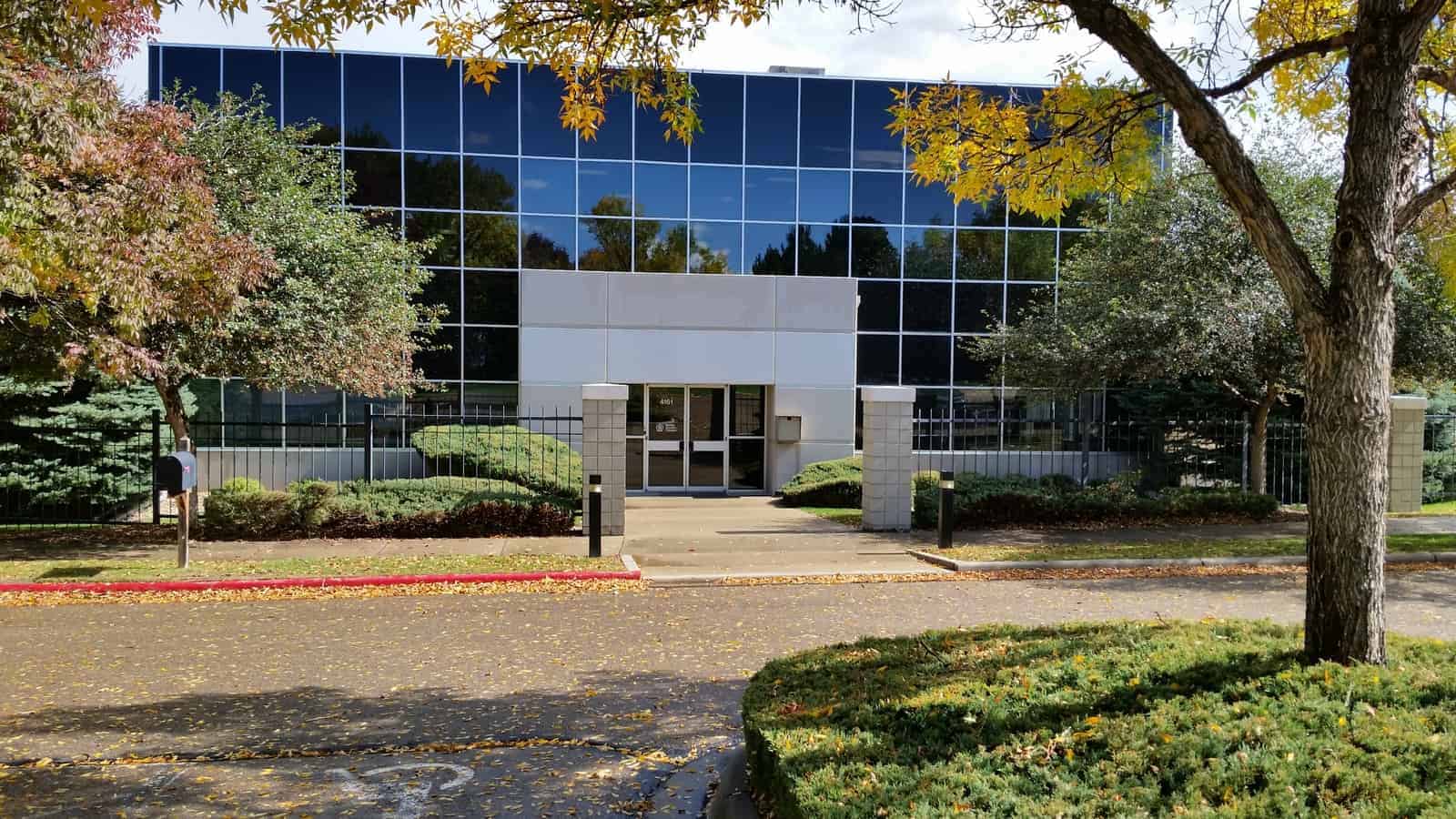
Under the Toxic Substances Control Act, businesses must keep up with all of the requirements and restrictions relating to chemical substances. Although manufacturers fulfill their obligations with the utmost care, the Environmental Protection Agency isn’t keeping up its end of the bargain.
Alan Dyke, Ph.D. is the chief technology officer at Boulder Scientific Company—a specialty chemical company based in Mead, Colorado—and a member of the Society of Chemical Manufacturers & Affiliates. In his opinion, the EPA must change its approach if manufacturers in the U.S. are to remain competitive.
The company: Serving clients in many sectors, from pharmaceuticals to defense and aerospace, Boulder Scientific makes a number of complex and unique catalysts and compounds. The company proudly keeps all their manufacturing processes inside the United States.
- “We work with an end user to produce materials inside America with the right level of safety and quality, and to make those materials available for them within American borders,” Dyke explained. “We don’t outsource any manufacturing outside the U.S.”
The challenge: The EPA continues to miss congressionally mandated deadlines to review and approve compounds, creating havoc in an industry dependent on clockwork efficiency.
- “We’ve encountered delays because of the time it takes to file a document, the variability of response times from the EPA and the sheer number of documents we have to file,” said Dyke.
- At the same time, the EPA is imposing more regulations on chemical manufacturers that are difficult to navigate or confusing.
- “To make one of our compounds might take 10 different chemical intermediates from the first raw materials through to the end product,” he explained. “Each one of those materials requires a filing for each one of those compounds. And if any one of those steps is not approved, it interrupts our delivery process.”
The impact: These problems don’t just affect chemical manufacturers; they also cause problems throughout the supply chain and for customers and end users, who are forced to wait through a series of unpredictable delays.
- “During the past two years, we’ve seen a level of frustration building at the end-user level,” said Dyke. “Customers are considering sourcing from other countries where the system is more predictable and they won’t have to face these delays.”
The next step: Should the EPA fail to correct its course, even businesses dedicated to remaining in the U.S. may reach a breaking point, Dyke cautioned.
- “We are considering sourcing raw materials and advanced intermediates in other countries—and even establishing manufacturing in other countries—because registration and filing is easier in other places,” he said.
- “And that’s really concerning, because if we’re thinking about doing things outside the United States, then I can guarantee a number of SOCMA members are thinking similarly.”
The CHIPS effect: Even as the U.S. government encourages companies to manufacture semiconductor chips in the United States through the CHIPS Act, the EPA’s delays are making it harder to fulfill critical goals. Boulder Scientific, which does significant business with the chips industry, is caught up in this bottleneck.
- “The frustration from the folks who are buying those materials from us is that the incentive to support the CHIPS Act is strong, whereas the current EPA filing process is not efficient—and so there’s a mismatch,” said Dyke. “We’re not able to perform the way we would want to in support of that government incentive.”
The last word: “Manufacturers are facing an onslaught of environmental regulations like we have never seen before,” said NAM Vice President of Domestic Policy Brandon Farris. “The industry supports commonsense regulations that contribute to a healthy environment but don’t prevent manufacturers from creating the products that make modern life possible.”
The NAM, members of the NAM’s Council of Manufacturing Associations and Conference of State Manufacturers Associations recently launched Manufacturers for Sensible Regulations, a coalition addressing the impact of the current regulatory onslaught coming from federal agencies. To learn more, and get involved, go here.
NAM, Rep. Stauber Talk R&D, Workforce
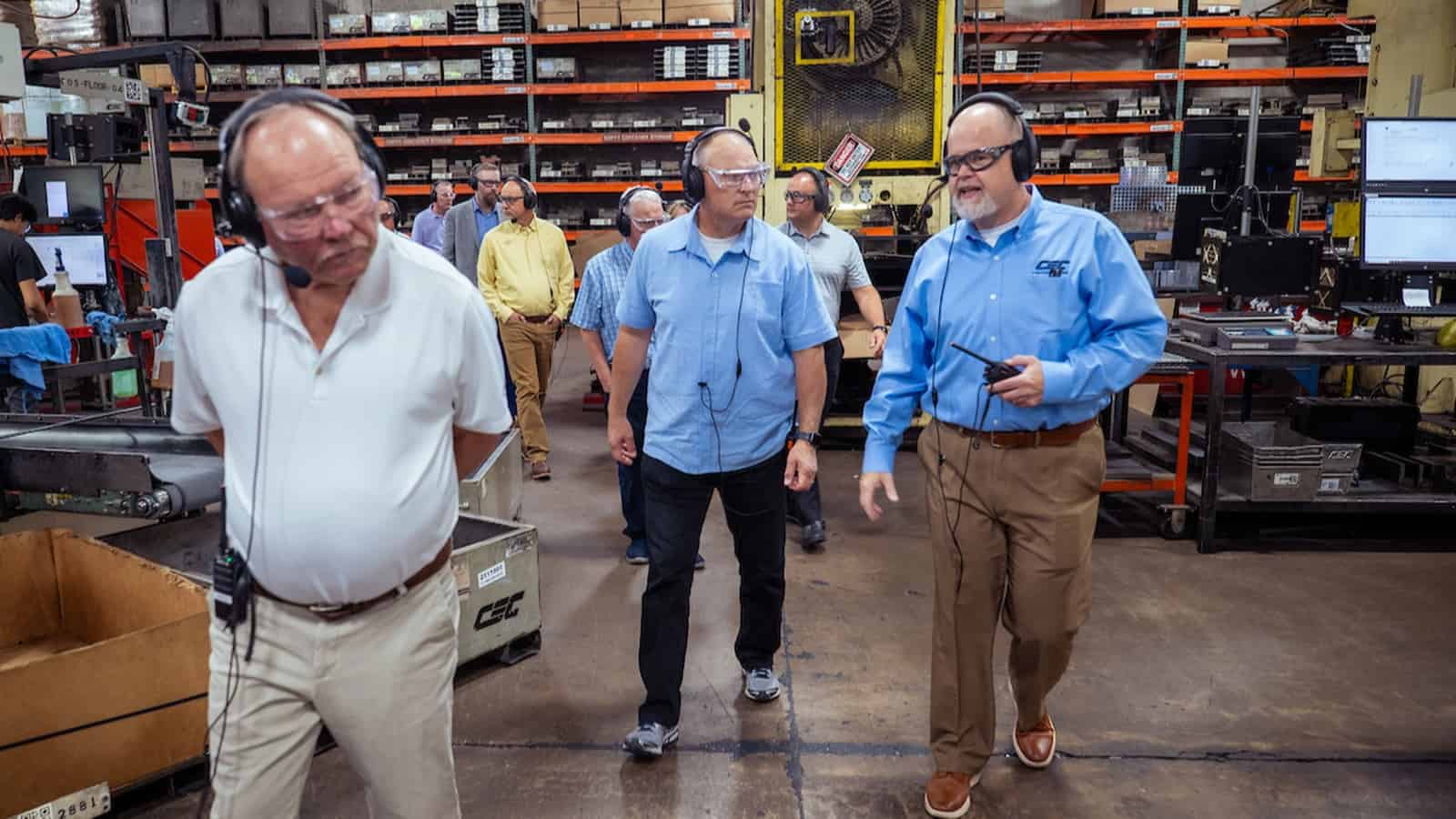
Permanent restoration of R&D expensing is a top priority for manufacturers in Minnesota and the U.S. in general. That’s why Rep. Pete Stauber (R-MN) plans to sign onto the American Innovation and R&D Competitiveness Act as a cosponsor, he recently told the NAM.
What’s going on: Rep. Stauber discussed the importance of competitive R&D tax policy, along with the regulatory onslaught targeting manufacturers and the need for permitting reform, during a recent NAM-organized facility tour of Clow Stamping Co. in Merrifield, Minnesota.
- “Full expensing for R&D costs in the year in which they are incurred is essential for innovation and competition,” Rep. Stauber told the group, which included Pequot Tool & Manufacturing CEO Karlo Goerges in addition to NAM representatives and Clow Stamping leadership. “It’s imperative that it be reinstated as soon as possible.”
- The American Innovation and R&D Competitiveness Act would restore immediate R&D expensing permanently for small businesses.
- “Full R&D expensing was instrumental in our growth until the law changed last year,” said Clow Stamping owner Reg Clow. “It’s definitely having an impact on us. Our expenses have gone way up.”
Workforce woes: Clow is nearing the end of a $20 million facility expansion that will add 107,000 square feet of floor space and at least 60 jobs—but finding enough workers to fill those jobs won’t be easy.
- By implementing automation in its shipping and receiving departments, the company will be able to both increase its shipping output without additional workers and channel its current hiring efforts toward filling open positions with the production departments, Clow said.
- This is a short-term solution, however, and manufacturers like Clow Stamping need policymakers’ help to ensure the industry has enough skilled workers for the decades to come.
- During the facility visit, the group discussed the importance of educating younger generations about the many opportunities available in manufacturing, via initiatives like Creators Wanted. This award-winning perception campaign undertaken by the NAM and its 501(c)3 workforce development and education affiliate, the Manufacturing Institute, aims to recruit 600,000 new manufacturing workers by 2025.
The last word: “Manufacturers account for more than 55% of all private-sector R&D spending in the United States,” said NAM Managing Vice President of Policy Chris Netram.
- “Policies that encourage this innovation will allow the industry to continue to drive our economy forward. The NAM thanks Rep. Stauber for his support of the American Innovation and R&D Competitiveness Act and calls on Congress to swiftly pass this bill.”
NAM to FTC: Withdraw Proposed Merger Rules
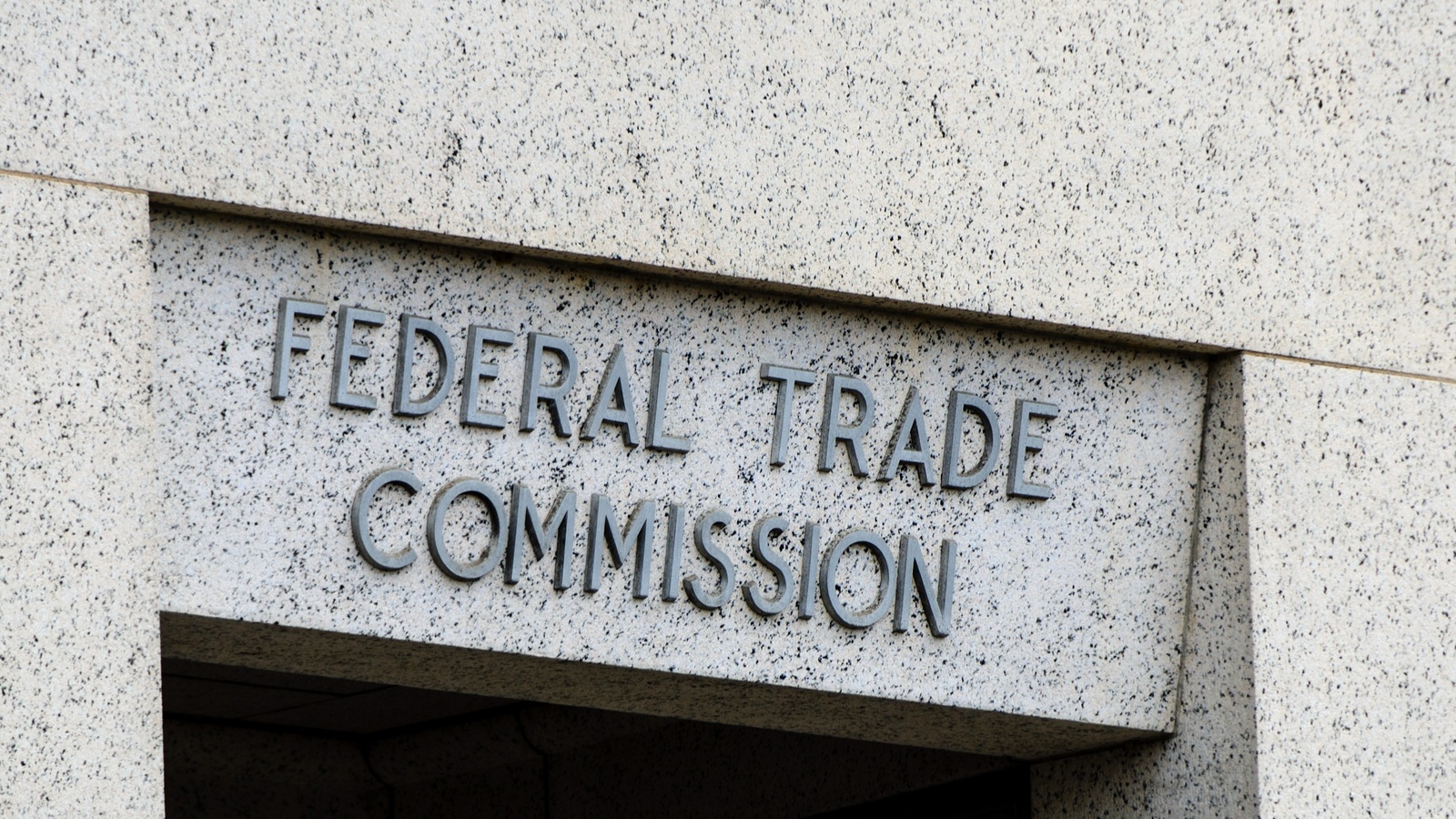
The NAM is pushing back on proposed changes by the Federal Trade Commission and the Department of Justice that would expand filing requirements drastically for companies considering mergers, harming manufacturers of all sizes.
What’s going on: In June, the FTC—with the agreement of the Antitrust Division of the DOJ—announced an overhaul of the premerger notification rules under the Hart-Scott-Rodino Act.
- The HSR Act requires companies to provide notice to the FTC prior to consummating a merger, but the FTC’s proposed changes would lead to as much as a sevenfold increase in the time it takes to file the HSR form, according to the proposal.
- The proposed amendments would also necessitate complex and lengthy information reporting, as well as significantly enhanced document production—resulting in disclosure overload for companies pursuing mergers or acquisitions.
Why it matters: M&A activity is critical to the manufacturing industry. Larger businesses use M&A for efficiency and expansion, while smaller companies benefit from opportunities for capital formation and growth.
- The burdensome nature of the FTC’s proposal could disincentivize or delay promising, pro-consumer deals.
Manufacturers speak out: Last week, the NAM urged the FTC to withdraw the proposed changes to “protect businesses’ ability to grow and drive economic expansion in the United States.”
- The proposal would result in significant costs and delays for manufacturers, “stifl[ing] job-creating growth in the manufacturing industry without any corresponding benefit to the agencies, merging parties or the public,” NAM Vice President of Domestic Policy Charles Crain told the FTC.
- “If adopted, the proposal would dramatically increase the information that merging entities would be required to provide to the agencies before consummating a transaction … postponing the opportunities and job-creating investments that these transactions can create,” he added.
SCOTUS Affirms Manufacturers’ Call for Skilled Worker Support Program
Washington, D.C. – Following the U.S. Supreme Court’s denial of cert to reconsider the D.C. Circuit’s decision affirming the validity of Optional Practical Training extension for STEM graduates, a program that expands access to hundreds of thousands of skilled workers for manufacturers and other American businesses, National Association of Manufacturers Chief Legal Officer Linda Kelly released the following statement:
“Today’s decision ends a years-long legal battle, and the NAM Legal Center is proud to have fought to preserve the STEM OPT program, which will aid manufacturers in filling critical, skilled positions. Thanks to the NAM Legal Center’s efforts, the STEM OPT program will remain a vital talent pipeline, providing opportunities for those graduates in science, technology, engineering and math to enhance their education through hands-on work.
Background: In 2018, after an anti-immigration activist group brought a lawsuit against the Department of Homeland Security seeking to invalidate the entire STEM OPT program, the NAM and two other business groups moved to intervene as defendants in the case. The U.S. District Court for the District of Columbia ruled in the NAM’s favor in 2020, holding that DHS acted within its statutory authority and in accordance with the Administrative Procedure Act by continuing the STEM OPT program, a decision the D.C. Circuit affirmed in 2022. Today’s decision by the Supreme Court not to hear the case maintains the Circuit Court’s ruling and preserves the STEM OPT program.
-NAM-
The National Association of Manufacturers is the largest manufacturing association in the United States, representing small and large manufacturers in every industrial sector and in all 50 states. Manufacturing employs nearly 13 million men and women, contributes $2.91 trillion to the U.S. economy annually and accounts for 55% of private-sector research and development. The NAM is the powerful voice of the manufacturing community and the leading advocate for a policy agenda that helps manufacturers compete in the global economy and create jobs across the United States. For more information about the NAM or to follow us on Twitter and Facebook, please visit www.nam.org.
